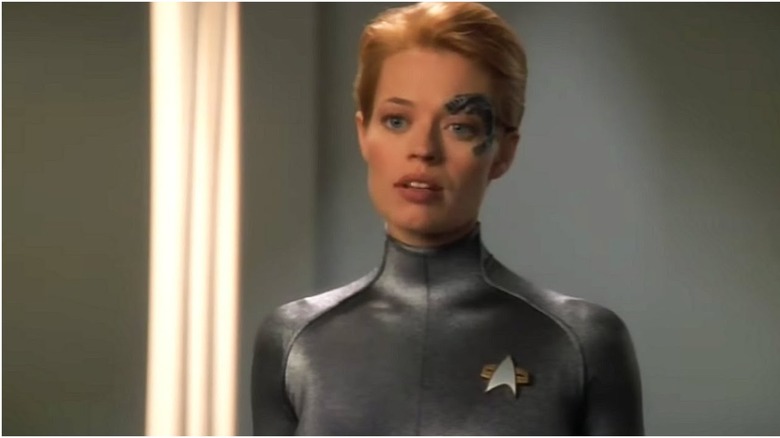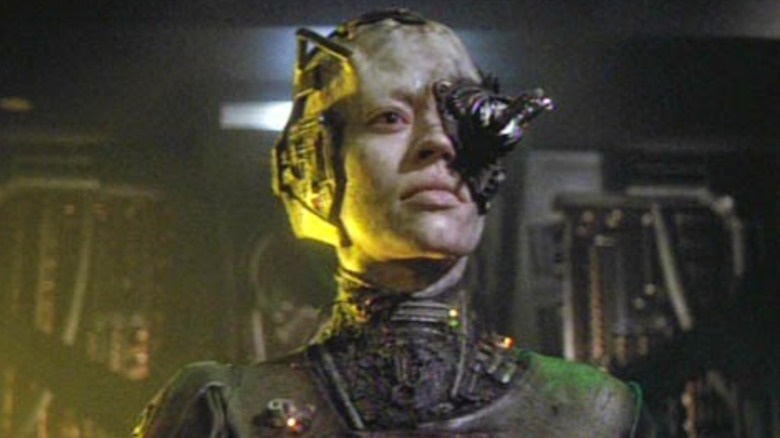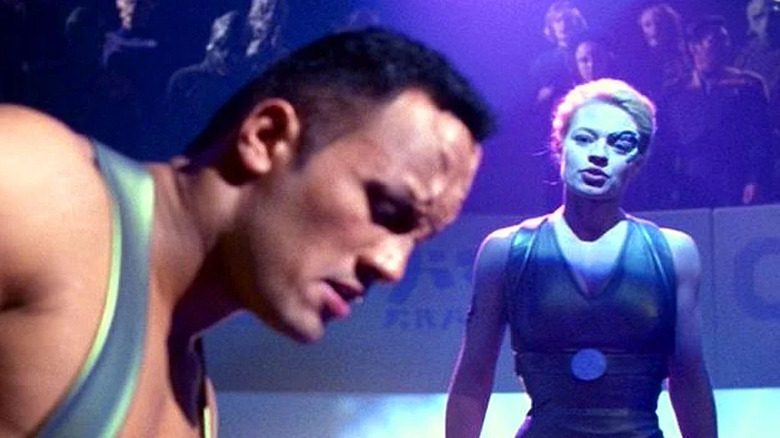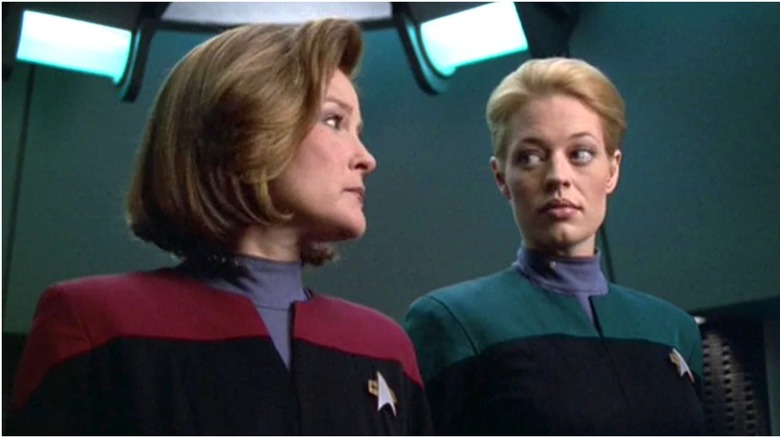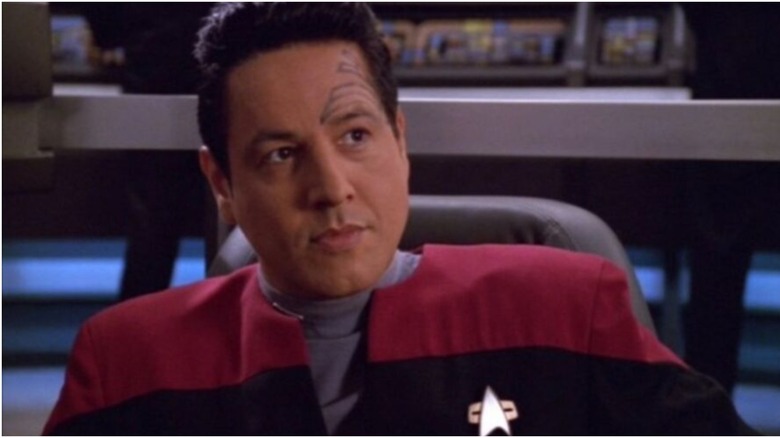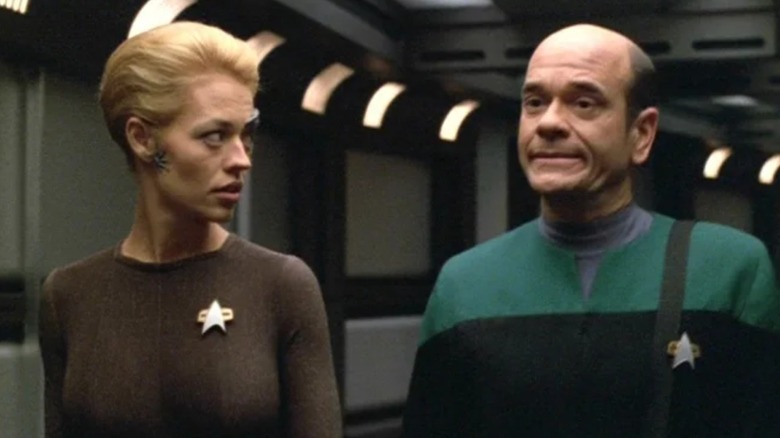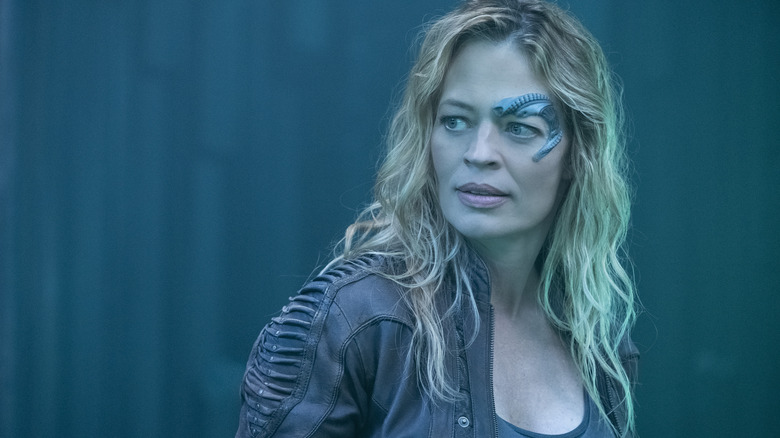Seven Of Nine's Arrival On Star Trek: Voyager Came With Some Growing Pains
Sometimes, the greatest and most famous characters on a television show are the ones who were added part-way through the series. That's absolutely the case with "Star Trek: Voyager" and its breakout character, liberated Borg drone Seven of Nine (Jeri Ryan). Joining the show in season 4, Seven's sex appeal was obvious, but she rose beyond the expectations for a fan-service character. Her journey back to something resembling normalcy after being assimilated made her one of the few characters on the show with concrete character development, and Ryan played the part excellently. Instantly popular, she practically became the show's star, especially in advertising.
Of course, not all of Ryan's castmates took kindly to having the spotlight diverted from them, and this led to some friction behind the scenes.
Reintroducing the Borg
In "Voyager," the titular ship is stranded in the Delta Quadrant of the Milky Way galaxy. Two crews, Voyager's own and members of the rebel movement the Maquis, must join forces to get back home to the Alpha Quadrant. The Delta Quadrant had been established as home to the Borg, but the writers held off on giving their heroes such a challenge during the first two seasons. "Star Trek: The Next Generation" established a single Borg Cube could wipe out a Federation fleet; showing a single, lone Starfleet vessel besting them week after week would've strained credibility. Plus, villains as scary as the Borg are best served in small doses.
The Borg first appeared on "Voyager" during season 3 episode "Unity," which features a group of drones disconnected from the larger collective. This premise wasn't exactly a novel idea; "TNG" episodes "I, Borg," and "Descent" had previously used "drones cut off from the larger Borg" as a way to tell a Borg story minus apocalyptic stakes. However, the episode had a significant, albeit indirect, impact on the larger direction that "Voyager" charted.
According to "Star Trek Voyager: A Celebration" (by Ben Robinson and Mark Wright), when writer and producer Brannon Braga was watching a promo for "Unity," an idea for a disconnected Borg drone joining Voyager's crew came to him. His producing partner Rick Berman was also for the idea, but steered the concept away from a "cybernetic looking creature" like Braga initially envisioned. Instead, the character would give "Voyager" new sex appeal.
The two-part season 3 finale and season 4 premiere "Scorpion" introduced Seven of Nine. In these episodes, USS Voyager forms an alliance with the Borg against extra-dimensional invaders known as Species 8472. The collective chooses Seven as a representative to communicate with Voyager. When the alliance is over, she turns on the crew, who respond by severing her link to the collective. Now an individual for the first time since childhood, Seven is slowly assimilated by Voyager.
Ryan speaks up
"Scorpion" marks a sea change for "Voyager." From there on out, the Borg became the main villains of the series. Plus, as Seven came onto the show, Kes (Jennifer Lien) departed. For many years, rumors swirled that the price of Jeri Ryan joining the show was another cast member getting the boot; however, based on interviews with the cast and crew conducted for "A Celebration" by Robinson and Wright, Lien's personal problems, including substance abuse, were affecting her performance and this was the real reason for her leaving.
Still, that left Ryan in the always awkward position of the new guy, not helped by her being the effective replacement for someone the rest of the cast had acted alongside for three years. During an appearance on the "girl on guy" podcast in 2013, Ryan recounted the ups and downs of her "Voyager" experience; the transition was far from easy:
"That's hard when the new kid comes in and suddenly it's all about them. That was tough, and it was particularly tough for some more than others, which was not real fun ... basically, until I started dating [Brannon Braga]. Once I was dating the boss, funny how things suddenly cleaned up. But it was really, really tough the first couple of years. and there were many days when I was nauseous before going into work because it was that miserable. Just unnecessarily, intentionally unpleasant."
While Ryan doesn't single anyone out in her comments, behind-the-scenes gossip indicates there was one main party responsible for this unpleasantness: Captain Janeway herself, Kate Mulgrew.
Ryan vs. Mulgrew
One of Seven's most important relationships is with Captain Janeway, who becomes a mentor to her. One of the best "Voyager" episodes, "Dark Frontier," is essentially about Seven being torn between two mother figures: Janeway and the Borg Queen (Susanna Thompson). However, according to the cast and crew, Mulgrew and Ryan's relationship was a different story. Rather than taking Ryan under her wing as Janeway did Seven, Mulgrew alienated her.
"The Fifty-Year Mission: The Next 25 Years: From The Next Generation to J. J. Abrams: The Complete, Uncensored, and Unauthorized Oral History of Star Trek" (by Edward Goss and Mark Altman) contains interviews with numerous "Voyager" cast and crew who shed light on the situation. In a nutshell, Mulgrew's treatment of Ryan was motivated by her frustrations that her character — a strong, empowered woman — was being upstaged by a role designed for maximum sex appeal.
Speaking to Goss and Altman, Berman described the situation between the two actresses as such:
"Kate was sort of the Queen of 'Star Trek'... She hung out with astronauts, she hung out with Hillary Clinton, and she was the spokesman for women in leadership roles, and for a lot of things. All of a sudden, this busty, gorgeous, blond babe appears who took away everybody's breath. I literally once remember some press being on the stage and just sort of pushing by Kate to get to Jeri."
In a separate interview for "The Fifty-Year Mission," Garret Wang (Harry Kim) added:
"Kate's anger was not directed toward Jeri Ryan, it was directed toward the character of Seven of Nine. She was the female captain, and now you bring in this borderline T-and-A character. When the writers/producers said no [to getting rid of Seven]... her anger was turned toward the actress playing the character, Jeri Ryan."
Mulgrew's attitude toward Ryan was steeped in her own frustrations, rather than being based on anything Ryan had done. Since the show concluded, Mulgrew has since cleared the air. In her own interview with Goss and Altman for "The Fifty-Year Mission," Mulgrew gave a more direct mea culpa:
"Let's be very straight about something. This is on me, not Jeri. She came in and did what she was asked to do. No question about that, and she did it very well. It's on me because I'd hoped against hope that Janeway would be sufficient. That we didn't have to bring a beautiful, sexy girl in. That somehow the power of my command, the vicissitudes of my talent would be sufficient unto the day, because this would really change television, right? That's what dug me the hardest, that to pick up the numbers they did that... that hurt me."
Seven overshadows the supporting cast
Mulgrew wasn't the only one who felt usurped by Ryan's role on the show. Speaking to StarTrek.com, Robert Beltran (Commander Chakotay) said:
"When the Seven of Nine character made her entrance, the focus changed... That was fine with me, but I think writers have an obligation to fill out all the characters if they're regular characters on a series. I think several of the characters were diminished — Chakotay and Tuvok and Kim and Neelix."
Beltran isn't wrong, but the mishandling of those characters predates Seven's introduction. Characterization was never the show's strong suit on "Voyager." Mulgrew at least had strong acting chops to compensate for the inconsistent writing of Janeway, but many of her co-stars couldn't compare, leaving their characters to fall into broad archetypes.
By the time Ryan came onto the show, "Voyager" had totally failed to use the most exciting part of its premise — the Starfleet and Maquis schism. When interviewed for "The Fifty-Year Mission," writer Ron Moore (of "TNG," "Deep Space Nine", and briefly "Voyager") opined, "When the Maquis put on those Starfleet uniforms at the end of the pilot, the show was dead." Season 3 episode "Worst Case Scenario" (a pre-Seven episode, I might add) features a holodeck simulation of a Maquis mutiny on USS Voyager. The episode reeks of the writing staff trying to have it both ways: introduce exciting new character conflict and preserve the status quo. Yet, the mutinous holographic Chakotay comes alive more than his real self ever does. With Chakotay reduced to a yes man, Seven wound up a better foil to Janeway than he ever was.
Not coincidentally, the one character who adapted best to the presence of Seven on "Voyager" who had been working well before her introduction: the Doctor (Robert Picardo).
My Fair Seven
"Star Trek" has a long tradition of characters learning what it meant to be human: Spock, Data, and Odo. At first, it seemed the Doctor would fill this role on "Voyager." An Emergency Medical Hologram (EMH) modeled on Dr. Lewis Zimmerman (also played by Picardo), the Doctor has to become Voyager's full-time medical officer after his human counterpart is killed in the pilot. His character avoided being a rehash of Data (an artificial intelligence seeking to become more) thanks to his cranky bedside manner (which had more in common with Doctor McCoy) and Picardo's charming performance.
However, once Seven was introduced and Kes was written out, Picardo became concerned. As he explained to StarTrek.com,
"Kes had really been The Doctor's mentor. Officially, he's mentoring her as a medical assistant, but she has been mentoring him and developing his humanity. My concern was that she's been his emotional sounding board, his confessor. The moment she's gone, The Doctor is just going to go back to being a buffoon and a windbag."
When Picardo brought his concerns to Brannon Braga, the writer suggested the actor find a way for the Doctor and Seven to connect. Picardo elaborated,
"I ... suggested that we take the relationship that the Doctor had with Kes and we turn it around. So the Doctor thinks that the best person to teach Seven of Nine how to become human again is him ... Eventually, that culminated in 'Someone to Watch Over Me,' akin to Professor Higgins falling in love with his pupil in 'My Fair Lady.' That suggestion afforded me four seasons of great scenes with Jeri Ryan."
Instead of usurping the Doctor's role as she had some of the other cast, Seven brought his character full circle. Therein lies the benefit of having three-dimensional characters: it's easier to make their relationships with each other compelling.
Settling old wounds
Since "Voyager" concluded, it seems that Mulgrew has come to regret how she treated Ryan and has gained a new appreciation for what Seven brought to the show. At a Las Vegas "Star Trek" convention in 2018, Mulgrew praised Seven's character and Braga's writing of her relationship with Janeway, "Seven of Nine is what [brought] Janeway to life, as a deeply human woman, I believe. And I am deeply grateful for that."
While it's hard to excuse Mulgrew's behavior, one can empathize with the root of her frustrations. Despite the bullying she endured from Mulgrew, Ryan doesn't seem to regret her time on "Voyager" and is proud of Seven. In an interview with the Huffington Post, she said:
"I don't have a problem with Seven's overtly sexual physical appearance, if only because of the way she was written and developed. If it was a crappy character, then OK. But she was so nuanced and beautifully written."
Indeed, Ryan returned as Seven in "Star Trek" Picard." One only hopes her transition back into the role was easier than when she first jumped into it.
